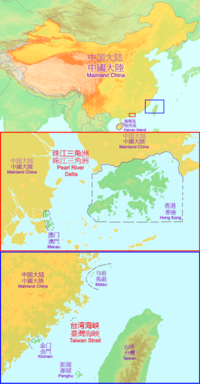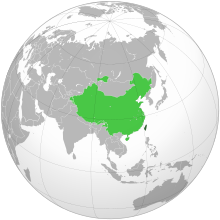Mainland China
Mainland China ( Chinese 中國 大陸 / 中国 大陆 , Pinyin Zhōngguó dàlù ) is a politico-geographical term that refers to most of what is now the territory of the People's Republic of China . Synonymous terms for this are continental China or mainland China . He describes part of Greater China as part of the one-China policy . It serves to delimit the two special administrative areas Hong Kong and Macau as well as the territory under the de facto control of the Republic of China ("National China ") on the island of Taiwan (formerly also known as Formosa) including the Pescadors (Penghu Islands) and the Mainland China's Kinmen and Matsu archipelagos . The "separate customs area Taiwan, Penghu, Kinmen and Matsu ( Chinese Taipei )" has been a member of the WTO since 2002 and of the APEC since 1991 (as a member economy Chinese Taipei ).
Legal status
People's Republic of China
The People's Republic of China, as part of its one-China policy, regards all four areas as being under its sovereignty .
According to Article 89 of the Entry and Exit Act, Hong Kong, Macau and Taiwan are considered overseas for border protection purposes.
In contrast, the term mainland China includes the island province of Hainan .
Republic of China
The Republic of China, under whose control only the island of Taiwan , Kinmen and the Penghu and Matsu Islands (so-called Taiwan area , 臺灣 地區 ) are de facto , considers the Chinese mainland under the official term mainland area ( 大陸 地區 ) de jure still as part of their national territory.
In 1982, the Supreme Court of the Republic of China ruled in Case No. 8219 ( 71 年 台上 字 第 8219 號 ), “The mainland of our nation is under the shackles of the Communist Party. This makes the practical exercise of national sovereignty difficult. Enforcement of the law is de facto restricted. Nonetheless, it is an integral part of the national territory. Its residents are members of the state association. The temporary loss cannot change the legal status. "
Mainland Chinese, like Taiwanese, are citizens of the Republic of China. Unlike foreigners, you do not need a visa to enter the Taiwan area, but a travel document issued by the Republic of China. As “nationals without permanent registered residence” ( 無 戶籍 國民 , Wú hùjí guómín ) you have a special legal status. So they are z. B. exempted from compulsory military service, but they are also not given the right to vote.
Individual evidence
- ↑ Ivan Dias : Letter to the bishops and priests in continental China. In: Fides Service . Pontifical Mission Societies , July 29, 2010, accessed August 25, 2015 .
- ^ Vatican: New Dialogue with China. In: Vorarlberg Online . Retrieved August 25, 2015 .
- ↑ Mass protests in Hong Kong - arrests also on mainland China. Retrieved August 25, 2015 .
- ^ Andreas Lorenz: Hong Kong and the mainland Chinese: Just no noodles in the subway . In: Spiegel Online . March 17, 2012 ( online [accessed August 25, 2015]).
- ↑ a b China - Facts and Figures 2000. In: german.china.org.cn. Retrieved August 25, 2015 .
- ↑ National China is created , Die Zeit No. 49 of December 8, 1949; Retrieved August 25, 2015.
- ↑ Economy. Federal Foreign Office , accessed on August 25, 2015 .
- ↑ China: Travel and Safety Advice. Federal Foreign Office, accessed on August 25, 2015 .
- ^ Elisabeth Gumpenberger: Between the mainland and the island - reasons for migration and the way of life of migrant workers in Bo'ao. In: Master's thesis. 2010, accessed August 25, 2015 .
- ↑ 臺灣 地區 與 大陸 地區 人民 關係 條例 ( zh-hant ) Accessed April 2, 2019.
- ↑ 裁判 字號 : 71 年 台上 字 第 8219 號 ( zh-hant ) Accessed November 4, 2018.
- ↑ 陸 客 來 臺 自由行 政策 說明 . Retrieved July 3, 2017.
- ^ ROC (Taiwan) Immigration Reference Guide for Civil Carriers . National Immigration Agency. March 18, 2011. Retrieved December 21, 2011.
- ↑ Roger Mark Selya, Development and Demographic Change in Taiwan (World Scientific, 2004), p. 329


